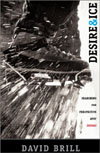
Two books take inspiration from downtown's places
Denali, which most of us grew up knowing as Mount McKinley, is the highest peak in North America. Its elusive summit is one of the chief quests of mountain climbers all over the world.
The mountain can be approached from several angles. Most of them require tedious months of training, more money than you might spend on your next car, two to four weeks of sleeping in close quarters with unwashed flesh, chancing horrific altitude-related brain disorders, eating jerky,  peeing in a bottle, and carrying your frozen poop around in a bag. peeing in a bottle, and carrying your frozen poop around in a bag.
None of that is required for what is, as far as I'm concerned, the best route, which is reading David Brill's fine book on the subject, Desire And Ice: Searching for Perspective atop Denali (National Geographic, $16). Brill, an editor for UT's Energy, Environment, and Resources Center, is also author of As Far as the Eye Can See, his Appalachian Trail odyssey. Brill, who lives in a remote, TV-less cabin in Morgan County, has gained further local celebrity status by surviving the Mossy Creek tornadoes without even knowing about them. He was reading a book, enjoying what he thought was a fine lightning storm.
Summer before last, Brill was on top of Denali. Brill doesn't get onto the mountain itself until about 100 pages in, and that's apropos. His training regimen started with power hikes up Frozen Head and proceeded to hiking Washington's Mt. Rainier. For many climbers, Rainier is a life accomplishment in itself; for Brill, it was training for Denali.
His companions on the mountain are an affluent Dirty Dozen, a disparate group of men who have little in common except that they're seasoned climbers, and that they're pretty well off. They won't all make it to the top.
Which is a little anticlimactic, at least in the book. The narrative is more than 200 pages long, but the description of the actual top of the continent takes up only two and a half paragraphs. I would have liked to know if there was anything up there: is there a marker, or the heroic remains of flagpoles, or the personal effects said to be deposited on top across the 90 years that people have been struggling and dying to get up there?
You read it for the getting there. The book's almost as hard to release as a lifeline on a glacier. On the way up, Brill includes some fascinating history of the mountain's earlier explorers and would-be explorers; the peak eluded several early efforts. A couple of early scenes take place in an unnamed bar in an unnamed city. It's the birthplace of the idea, and the book. I'm not sure why Dave kept it a secret, but for the record, it's Gay Street's brewpub, newly reopened as the Downtown Grill and Brewery.
Brill, who wrote about the trek for National Geographic Traveler, will be talking about Desire and Ice and showing slides of his adventure this Saturday at Blue Ridge Mountain Sports, newly relocated in Kingston Plaza (near Long's).
The book makes you feel sorry for, and worry about, all the poor clods who climb the mountain without getting to write a book about it.
—Jack Neely
Last summer, the Pulse serialized a small part of local author Jack Mauro's frothy romance Enola's Wedding. Now, the whole tale is available for $15.95 in self-published form at www.iuniverse.com. In case you missed those snippets, the plot of Wedding concerns itself with the nuptials of a local woman, the  machinations of her man-eating best friend, and the exercise routine of the groom-to-be. In the novel, you also get a healthy helping of sub-plots about a Southern anti-belle, a newspaperman, and a drunk mother. Knoxville itself becomes a character in this novel as well. machinations of her man-eating best friend, and the exercise routine of the groom-to-be. In the novel, you also get a healthy helping of sub-plots about a Southern anti-belle, a newspaperman, and a drunk mother. Knoxville itself becomes a character in this novel as well.
While the book has been available since June of '02, it has taken a couple of months to get to, in large part due to Mauro's precision with language. This is not a beach story—one to be read while broiling under a hot sun and only paying little attention to the actual words. It's more of a fireplace story—something to read while snuggled up indoors, devoting all of your mind-power to the words and dreaming of warmer days.
Mauro's dense verbiage is both his greatest asset and largest liability. His work doesn't read like most current literature; his greatest influence seems to be Dickens more than Clancy. Part of me wishes that he finds a strong-willed editor at a major publishing house (his skill is large enough for such leagues) who can cut some of the excess and hone Enola into the diamond-sharp gem it could be. Yet removing one word from most of Mauro's sentences would cause them to collapse. It'll be interesting to see what he comes up with next.
—Adrienne Martini

January 9, 2003 * Vol. 13, No. 2
© 2003 Metro Pulse
| 




